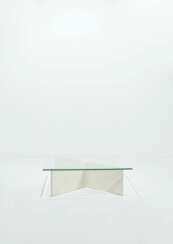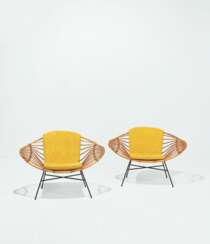
De la fonction à la COLLECTION, STÉPHANE DANANT une passion pour le design et l'art français des années 1955-1975.

Pierre Paulin was a French furniture designer and interior designer. His uncle Georges Paulin was a part-time automobile designer and invented the mechanical retractible hardtop, who was later executed by the Nazis in 1941 as a hero of the French Resistance. After failing his Baccalauréat, Pierre trained to become a ceramist in Vallaurius on the French Rivera and then as a stone-carver in Burgundy. Soon after, he injured his right arm in a fight, ending his dreams as a sculptor. He then went on to attend the Ecole Camondo in Paris. He had a stint with the Gascoin company in Le Havre where he gained an interest in Scandinavian and Japanese design. He was famed for his innovative work with Artifort in the 1960s and interior design in the 1970s.
At the time, his chair designs were considered very modern and unique and kick-started the successes of his designs among the younger population. Even today, his pieces are still being made and are sought after at auctions.

Pierre Paulin was a French furniture designer and interior designer. His uncle Georges Paulin was a part-time automobile designer and invented the mechanical retractible hardtop, who was later executed by the Nazis in 1941 as a hero of the French Resistance. After failing his Baccalauréat, Pierre trained to become a ceramist in Vallaurius on the French Rivera and then as a stone-carver in Burgundy. Soon after, he injured his right arm in a fight, ending his dreams as a sculptor. He then went on to attend the Ecole Camondo in Paris. He had a stint with the Gascoin company in Le Havre where he gained an interest in Scandinavian and Japanese design. He was famed for his innovative work with Artifort in the 1960s and interior design in the 1970s.
At the time, his chair designs were considered very modern and unique and kick-started the successes of his designs among the younger population. Even today, his pieces are still being made and are sought after at auctions.



Alain Jacquet is a French self-taught artist, a representative of the American Pop Art movement. In his series of works "Camouflages" the artist often contrasts masterpieces of art history, famous paintings of the past to advertising idols of his time. "Botticelli's Camouflage" (Birth of Venus) is one of his famous works.
Among other things, Jacquet used the techniques of silkscreen printing, photomechanical transfer and screen printing.


César (born Cesare Baldaccini) was a noted French sculptor.
César was at the forefront of the Nouveau Réalisme movement with his radical compressions (compacted automobiles, discarded metal, or rubbish), expansions (polyurethane foam sculptures), and fantastic representations of animals and insects.

César (born Cesare Baldaccini) was a noted French sculptor.
César was at the forefront of the Nouveau Réalisme movement with his radical compressions (compacted automobiles, discarded metal, or rubbish), expansions (polyurethane foam sculptures), and fantastic representations of animals and insects.

Roger Tallon was a French industrial designer.
Tallon and his team created hundreds of products, including industrial robots for Peugeot, the apparently purposeless 8mm film camera "Veronic", the Gallic 16 and 14 lathes for the Belgian company La Mondiale — a quantum leap in machine tooling —, airport vehicles, forklifts for Fenwick, graphic images for Fenwick Aviation, and a slide projector for Kodak.
In the art world, Tallon worked with Yves Klein, César Baldaccini, Arman, and was contacted by Catherine Millet, founder of the art press review, to create a brand that has hardly changed to this day.
Tallon became a household name[citation needed] in areas including tableware, furniture, interior design, reflector lamps for the German Erco, watches for Lip, ski boots for Salomon Group, toothbrushes for Fluocaril, oilcans for Elf, and so on.

Jean Fautrier was a French painter and sculptor associated with the Art Informel and Tachisme movements. He initially studied architecture before turning to painting in the early 1920s.
Fautrier's early work was influenced by Cubism and Surrealism, but he eventually developed a more abstract style characterized by thick impasto and expressive brushwork. He often used unconventional materials, such as asphalt, sand, and tar, to create textured surfaces that conveyed a sense of materiality.
During World War II, Fautrier was active in the French Resistance and went into hiding to avoid arrest by the Nazis. His experiences during the war had a profound impact on his work, which became darker and more introspective. He began to create what he called "Hostage" paintings, which depicted anonymous faces and figures that were both haunting and vulnerable.
After the war, Fautrier continued to explore themes of violence, trauma, and decay in his art. He created a series of "Otages" (Hostages) sculptures that were made from casts of human limbs and torsos. These works were highly controversial and provoked strong reactions from critics and the public alike.
Fautrier's influence on the development of Art Informel and Tachisme was significant, and he is regarded as one of the key figures of the movement. His work is represented in many major museums and collections around the world, including the Centre Georges Pompidou in Paris and the Museum of Modern Art in New York.



























































